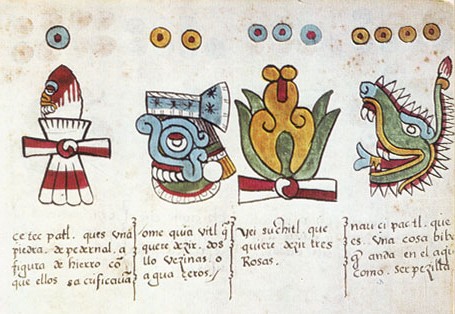|
Tlazōlteōtl
In Aztec mythology, Tlahzolteōtl (or , ) is a deity of sex, sexuality, lust, carnality, sin, vice, impurity, temptation, fertility, purification, absolution, steam baths, and a patroness of adulterers. She is known by three names, ("she who eats or filthy excrescence in) and ("the death caused by lust"), and or (, Deity of Cotton), the latter of which refers to a quadripartite association of four sister deities. is the deity for the 13th of the sacred 260-day calendar Tōnalpōhualli, the one beginning with the day , or First Movement. She is associated with the day sign of the jaguar. Tlazōlteōtl played an important role in the confession of wrongdoing through her priests. Aztec religion There was a Huastec mother goddess from the Gulf Coast who was assimilated into Aztec views of Tlazōlteōtl. Quadripartite deities Under the name of she was thought to be quadrupartite, composed of four sisters of different ages known by the names (the first born), (the youn ... [...More Info...] [...Related Items...] OR: [Wikipedia] [Google] [Baidu] |
Codex Borgia
The Codex Borgia ( The Vatican, Bibl. Vat., Borg.mess.1), also known as ''Codex Borgianus'', ''Manuscrit de Veletri'' and ''Codex Yohualli Ehecatl'', is a pre-Columbian Middle American pictorial manuscript from Central Mexico featuring calendrical and ritual content, dating from the 16th century. It is named after the 18th century Italian cardinal, Stefano Borgia, who owned it before it was acquired by the Vatican Library after the cardinal's death in 1804. The Codex Borgia is a member of, and gives its name to, the Borgia Group of manuscripts. It is considered to be among the most important sources for the study of Central Mexican gods, ritual, divination, calendar, religion and iconography. It is one of only a handful of pre-Columbian Mexican codices that were not destroyed during the conquest in the 16th century; it was perhaps written near Cholula, Tlaxcala, Huejotzingo or the Mixtec region of Puebla. Its ethnic affiliation is unclear, and could either have been produced ... [...More Info...] [...Related Items...] OR: [Wikipedia] [Google] [Baidu] |
Tōnalpōhualli
The (), meaning "count of days" in Nahuatl, is a Aztec, Mexica version of the 260-day calendar in use in pre-Columbian Mesoamerica. This calendar is solar and consists of 20 13-day () periods. Each is ruled by a different deity. Graphic representations for the twenty day names have existed among certain ethnic, linguistic, or archaeologically identified peoples. Description The term for the Aztecs, Aztec day signs, ''tōnalpōhualli'', comes from the root word ''Tona'' which means to give light or heat. T''ōnalpōhualli'' refers to the count of the days, made up of 20 day signs and a 260 day cycle. In Aztec society there were multiple intertwining calendars, the ''tōnalpōhualli'', and the ''xiuhpōhualli'' which refers to the solar year of 365 days. The ''xiuhpōhualli'' was divided into eighteen twenty day months, and then an extra five days at the end of the cycle. Each day denoted by a different day sign and number, the double calendars were intertwined so that every ... [...More Info...] [...Related Items...] OR: [Wikipedia] [Google] [Baidu] |
Tezcatlipoca
Tezcatlipoca ( ) or Tezcatl Ipoca was a central deity in Aztec religion. He is associated with a variety of concepts, including the night sky, hurricanes, obsidian, and conflict. He was considered one of the four sons of Ometecuhtli and Omecihuatl, the primordial dual deity. His main festival was Toxcatl, which, like most religious festivals of Aztec culture, involved human sacrifice. Tezcatlipoca's nagual, his animal counterpart, was the jaguar. In the form of a jaguar he became the deity Tepeyollotl ("Mountainheart"). In one of the two main Aztec calendars (the Tonalpohualli), Tezcatlipoca ruled the trecena ''1 Ocelotl'' ("1 Jaguar"); he was also patron of the days with the name ''Acatl'' ("reed"). A strong connection with the calendar as a whole is suggested by his depiction in texts such as the Codex Borgia and Codex Fejéváry-Mayer, where Tezcatlipoca is surrounded by day signs, implying a sort of mastery over them. A talisman related to Tezcatlipoca was a disc ... [...More Info...] [...Related Items...] OR: [Wikipedia] [Google] [Baidu] |
First Born
A firstborn (also known as an eldest child or sometimes firstling) is the first child born to in the birth order of a couple through childbirth. Historically, the role of the firstborn child has been socially significant, particularly for a firstborn son in patriarchal societies. In law, many systems have incorporated the concept of primogeniture, wherein the firstborn child inherits their parent's property. The firstborn in Judaism, the ''bechor'', is also accorded a special position. History Alfred Adler (1870–1937), an Austrian psychiatrist, and a contemporary of Sigmund Freud and Carl Jung, was one of the first theorists to suggest that birth order influences personality in the late nineteenth and early twentieth centuries. He argued that birth order can leave an indelible impression on an individual's style of life, which is one's habitual way of dealing with the tasks of friendship, love, and work. According to Adler, firstborns are "dethroned" when a second child comes ... [...More Info...] [...Related Items...] OR: [Wikipedia] [Google] [Baidu] |
Dumbarton Oaks Birthing Figure
The Dumbarton Oaks birthing figure is a possibly Aztec scapolite figurine of a woman giving childbirth in a squatting position. Housed in the Dumbarton Oaks collection, United States, the figurine is considered by several scholars to be a pre-Columbian artwork, while others believe it was made in modern times, possibly in the 19th century. The figurine measures 20.2 cm in height. Birthing figures, while common in Colonial Mexican manuscripts, are rare in Aztec three-dimensional art. Women, however, occupied a prominent position in the Aztec mythology. Provenance Early mentions of the figurine come from Ernest-Théodore Hamy, who first saw it in a Paris antique store. The figurine was later bought by French obstetrician and collector Alban Ribemont-Dessaignes. In 1947, the figure was acquired by Robert Woods Bliss, the founder of Dumbarton Oaks. Authenticity The first scholarly article about the figurine was written by Ernest-Théodore Hamy in 1899 and called it "absolutely ... [...More Info...] [...Related Items...] OR: [Wikipedia] [Google] [Baidu] |
Golden Idol , a cult image made by the Israelites when Moses went up to Mount Sinai
{{disambiguation ...
Golden idol may refer to: * Golden Idol, a fictional artifact in the ''Indiana Jones'' franchise * '' The Golden Idol'', a 1954 American film * '' Golden Idol'', a video game series * Golden Idol, a fictional artifact in the amusement ride Volkanu: Quest for the Golden Idol See also * Golden calf According to the Torah, the Bible, and the Quran, the golden calf () was a cult image made by the Israelites when Moses went up to Mount Sinai (bible), Mount Sinai. In Hebrew, the incident is known as "the sin of the calf" (). It is first mentio ... [...More Info...] [...Related Items...] OR: [Wikipedia] [Google] [Baidu] |
Raiders Of The Lost Ark
''Raiders of the Lost Ark'' is a 1981 American action-adventure film directed by Steven Spielberg and written by Lawrence Kasdan, based on a story by George Lucas and Philip Kaufman. Set in 1936, the film stars Harrison Ford as Indiana Jones, a globetrotting archaeologist vying with Nazi German forces to recover the long-lost Ark of the Covenant which is said to make an army invincible. Teaming up with his tough former romantic interest Marion Ravenwood ( Karen Allen), Jones races to stop rival archaeologist René Belloq ( Paul Freeman) from guiding the Nazis to the Ark and its power. Lucas conceived ''Raiders of the Lost Ark'' in the early 1970s. Seeking to modernize the serial films of the early 20th century, he developed the idea further with Kaufman, who suggested the Ark as the film's goal. Lucas eventually focused on developing his 1977 film ''Star Wars''. Development on ''Raiders of the Lost Ark'' resumed that year when he shared the idea with Spielberg, who jo ... [...More Info...] [...Related Items...] OR: [Wikipedia] [Google] [Baidu] |
Ochpaniztli
Ochpaniztli is the Eleventh Month of the Aztec calendar. It is also a festival in the Aztec religion dedicated to Toci and Tlazolteotl and is also the month of cleaning or sweeping away. Meaning Ochpaniztli was largely concerned with sweeping, which was a reference to the rush of winds that occurred in the valley of Mexico before the winter rains came, the end of the growing season and the start of the harvesting season. The Belgian historian Michel Graulich argued that the Mexica calendar was defective, and that Ochpaniztli, which means the "Sweeping of the Roads" in Nāhuatl was being celebrated at the wrong time of the year. The Mexica had originated somewhere considerably to the north of the valley of Mexico in a place they called Aztlán. Graulich argued that the calendar had been devised for their more temperate climate of their homeland and did not make allowances for the tropical weather in the valley of Mexico. The harvesting season of war was when the Mexica (better ... [...More Info...] [...Related Items...] OR: [Wikipedia] [Google] [Baidu] |
Art Journal (College Art Association Journal)
''Art Journal'', established in New York City in 1941, is a publication of the College Art Association of America (referred to as "CAA"). As a peer-reviewed, professionally moderated scholarly journal, its concentrations include: art practice, art production, art making, art history, visual studies, art theory, and art criticism. The main contributors are artists, scholars, critics, art historians, and other writers in the arts. It is both national and international in scope, and in recent years focusing on 20th- and 21st-century art, although for its first decades it concentrated more on earlier time periods in art history. It was originally published by the College Art Association as ''Parnassus'' (1929–1941), then ''College Art Journal'' (1941–1960), before changing its name to ''Art Journal'' in 1960. Membership in CAA includes subscription to ''Art Journal''. But single issues can be purchased. Back issues are available on JSTOR and ProQuest, among other databases. Awa ... [...More Info...] [...Related Items...] OR: [Wikipedia] [Google] [Baidu] |
Gold
Gold is a chemical element; it has chemical symbol Au (from Latin ) and atomic number 79. In its pure form, it is a brightness, bright, slightly orange-yellow, dense, soft, malleable, and ductile metal. Chemically, gold is a transition metal, a group 11 element, and one of the noble metals. It is one of the least reactivity (chemistry), reactive chemical elements, being the second-lowest in the reactivity series. It is solid under standard temperature and pressure, standard conditions. Gold often occurs in free elemental (native state (metallurgy), native state), as gold nugget, nuggets or grains, in rock (geology), rocks, vein (geology), veins, and alluvial deposits. It occurs in a solid solution series with the native element silver (as in electrum), naturally alloyed with other metals like copper and palladium, and mineral inclusions such as within pyrite. Less commonly, it occurs in minerals as gold compounds, often with tellurium (gold tellurides). Gold is resistant to ... [...More Info...] [...Related Items...] OR: [Wikipedia] [Google] [Baidu] |
Classical Nahuatl
Classical Nahuatl, also known simply as Aztec or Codical Nahuatl (if it refers to the variants employed in the Mesoamerican Codices through the medium of Aztec Hieroglyphs) and Colonial Nahuatl (if written in Post-conquest documents in the Latin Alphabet), is a set of variants of Nahuatl spoken in the Valley of Mexico and central Mexico as a ''lingua franca'' at the time of the 16th-century Spanish conquest of the Aztec Empire. During the subsequent centuries, it was largely displaced by Spanish and evolved into some of the modern Nahuan languages in use (other modern dialects descend more directly from other 16th-century variants). Although classified as an extinct language, Classical Nahuatl has survived through a multitude of written sources transcribed by Nahua peoples and Spaniards in the Latin script. Classification Classical Nahuatl is one of the Nahuan languages within the Uto-Aztecan family. It is classified as a central dialect and is most closely related to t ... [...More Info...] [...Related Items...] OR: [Wikipedia] [Google] [Baidu] |



